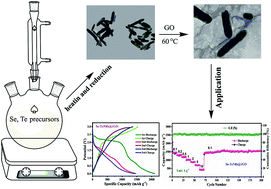Construction of well-designed 1D selenium–tellurium nanorods anchored on graphene sheets as a high storage capacity anode material for lithium-ion batteries
Abstract
Lithium ion batteries are considered to be smart power sources for applications in a broad range of portable electronics and fast-growing electric vehicles. However, the existing electrode system suffers from a limited lifespan triggered by lithium alloying agglomeration, which affects the full-scale reversible insertion of Li+ into the anode material. The discovery of novel alternative strategies that could improve the lifespan and rate performance of active electrode materials is of immense importance. Herein, we fabricated two semiconductor metalloids, selenium and tellurium, into a 1D architecture (Se/Te nanorods) and subsequently wrapped in reduced graphene oxide (rGO) nanosheets. The designed Se/Te nanorods at GO material is named Se/Te@rGO composite and investigated as the anode material for Li+ ion batteries. The Se/Te@rGO electrode showed an exceptional reversible storage capacity of 1456 mA h g−1 as compared to SeNr (400 mA h g−1) and Se/TeNr (800 mA h g−1) at 0.1 A g−1 after 100 cycles. Furthermore, when cycled at 5 A g−1, the Se/Te@rGO electrode showed an initial specific capacity of 804 mA h g−1 and retained a high specific capacity of 704 mA h g−1 after 3000 cycles (99.5% C.E), indicating the superior performance of the newly fabricated hybrid material. The improved electrochemical storage performance of the Se/Te@rGO electrode material could be ascribed to the 1D Se/Te nanorod architecture, which can provide a short diffusion path for Li-ions and buffer the strain produced during charge–discharge cycles. The incorporated 2D rGO template further enhanced the mechanical strength of the active Se/Te material and suppressed its dissolution and volume expansion during lithiation/delithiation processes. Our contribution highlights substantial progress in the development of high storage materials for applications in long-life Li-ion batteries.



 Please wait while we load your content...
Please wait while we load your content...